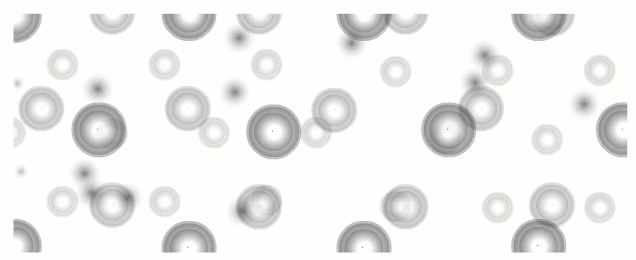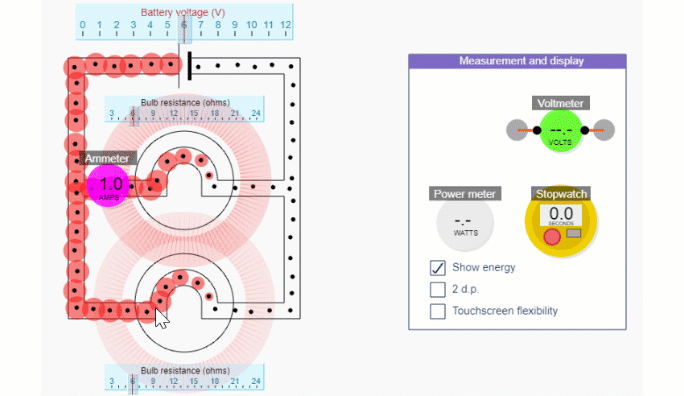
Simulations, animations and videos to teach Electricity - and now Radioactivity, too!
Unique insights into the physics. Easy for teachers, but amazing for students.
Our circuit simulations let students ‘see’ current and energy
Move seamlessly from visualisation to the mathematics.
Our decay simulation shows changing nuclei AND radiation
Bring half-life to life, and see the iron-clad connection with radioactivity
Use in front of a class or as self-paced lessons.
Simulations and animations
For whole-class teaching
3-minute videos
For the classroom or for home learning
Online quizzes
Based on the visuals you’ve used to teach
Lessons covering the whole GCSE current electricity and radioactivity syllabus
Electricity Explained gives depth to the GCSE syllabus, rather than expanding it.
Looks great - sure. But it's the physics under the hood that makes us different
Everything is founded on a deep understanding of electric circuits and how to teach them.
Do your existing resources get these right?
How batteries behave
Batteries are constant voltage providers. (They’re not constant current providers)
If you change the resistance in a parallel circuit the battery provides a different current. (It doesn't just ‘split’ differently)
Batteries run out of chemicals to react (physical) or their store of energy (theoretical). (They don't run out of electrons)
Resistance in simple circuits
Heating happens where the resistance is, but increasing the resistance causes less heating, not more. (Charges don’t expend more energy ‘overcoming’ a higher resistance)
If you increase resistance, batteries work less hard, not harder. (Batteries don't struggle harder to try and reach some target current)
The rope loop model gets both of these wrong.
Sub-microscopic view
Charges make very slow progress, but are already there everywhere in the circuit, and start moving everywhere at almost exactly the same time. (They don't start from the battery and move quickly)
All changes to current or potential happen everywhere nearly instantly, not just connecting and disconnecting. (The speed of the charges is not the speed of the change)
Trusted by physics teachers for more than 20 years
Furry Elephant is reborn
-
Since then, Furry Elephant has been through many incarnations, which finally came to an end when Flash was dropped by major browsers in 2020.
I had long-since moved away from physics teaching, but was amazed and humbled by the number of teachers contacting me from all over the world asking how they were going to teach electricity without Furry Elephant.
So I’ve rewritten the major simulations in JavaScript, and repurposed many of the most popular visualisations into gifs or videos, which is what you see today in this brand new incarnation - Electricity Explained.
It’s all about teaching and learning
-
The circuit simulation is a means to an end - I’m trying to clarify the ideas that are difficult to teach and to be explicit about misconceptions - misconceptions that I certainly had when I was a beginning teacher under the great Jon Ogborn at London University Institute of Education.
For me, it’s not about going beyond the syllabus, but being crystal clear about the minimum knowledge you need to have a full understanding of the absolute foundations - for example that the charges are already there, and that they progress very slowly
Crunchy physics in a soft coating
-
It’s not about being abstruse or complex, it’s about having an insight into how to explain the most fundamental ideas in the simplest and most accessible way possible.
I’m quite clever, but I’m not very, very clever, and that means that I have to go on the same painful learning journey as most students and teachers.
As Jon Ogborn once said to me ‘I wouldn’t say I’m an expert, but I’ve thought about it very hard.’ I’ve thought about teaching electricity very hard over the past two decades - I think I understand it about 8.5/10. You can judge for yourself. Welcome to Electricity Explained.
Let’s get started with Electricity Explained
Used by the world’s most innovative physics teachers since 2001
Insights into teaching and learning electricity
Why the rope loop is not great at predicting circuit behaviour
It’s claimed that the rope model has predictive powers - the problem is that in almost every case it predicts the exact opposite of how real circuits behave…more
Electrical ‘resistance’ is only a metaphor
The idea of electrical resistance is a horrible concept, and causes no end of confusion, though people are rarely aware that they’ve been confused. It’s one of the main…more
Battery voltage and the invisible 4th Law of electric circuits
When we have a simple circuit and we change the resistance, most teachers will simply say that you use the I=V/R relationship to calculate the new current…more
How batteries decide their chemical reaction rates
Batteries change the rate their chemical reactions run at depending on what they’re connected to - but how do they know what rate that should be?…more
Do charges ‘really’ carry energy?
They may or may not, but it really helps explain voltage and power if you pretend they do, and make this pretence explicit…more
The secrets to understanding electric circuits
Here are some rules of thumb that are either unmentioned or misunderstood in other resources that are really useful for understanding circuits… more












